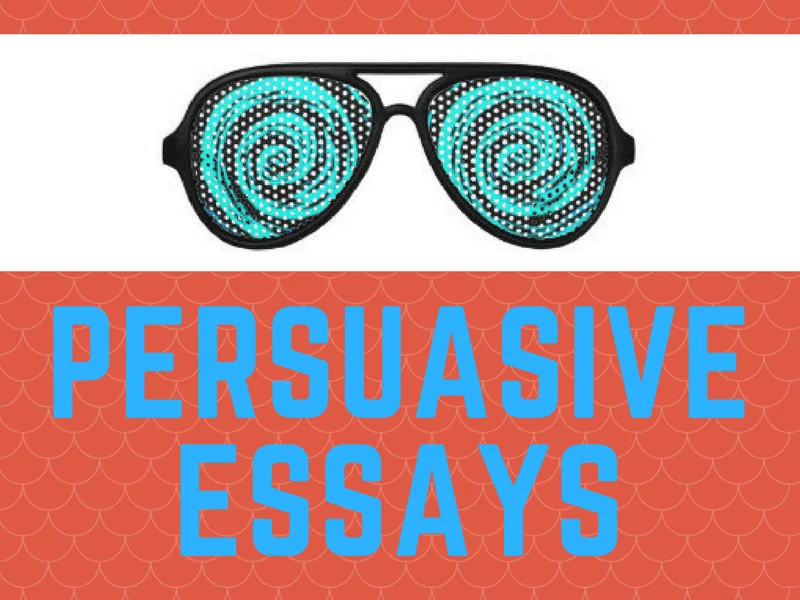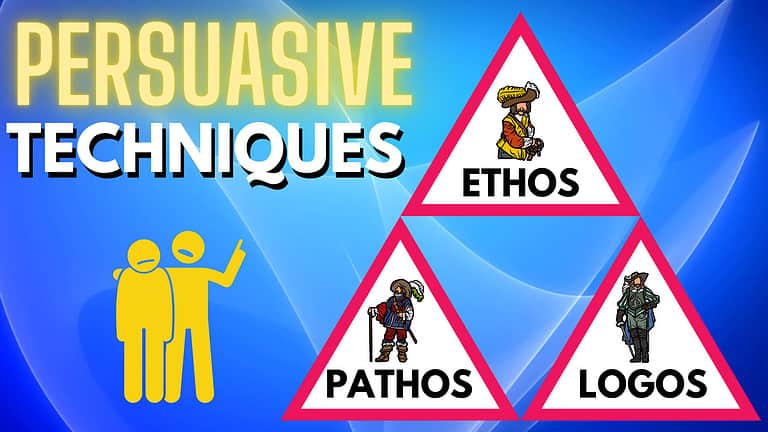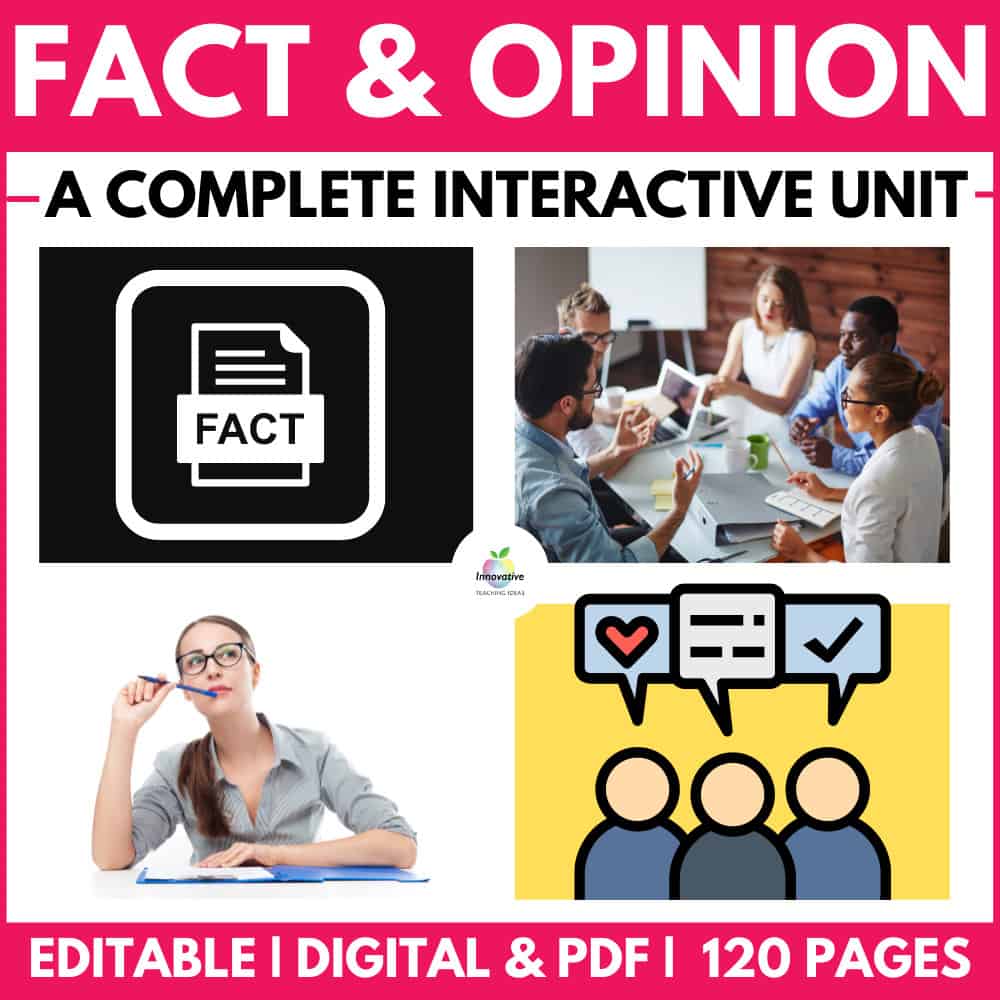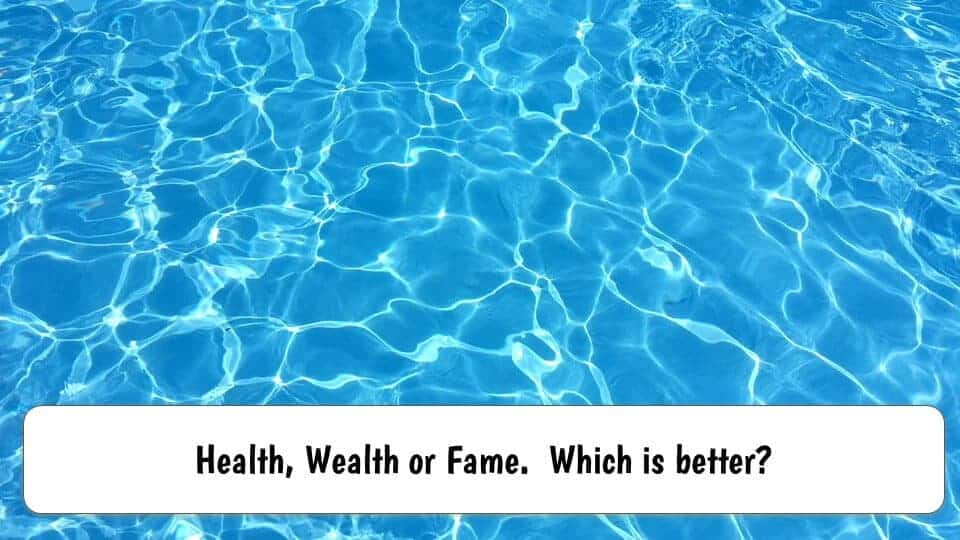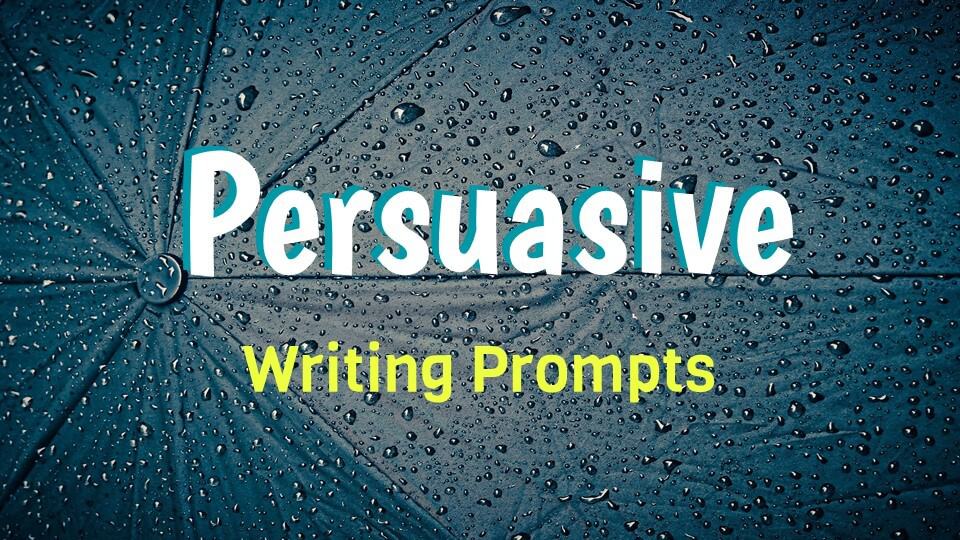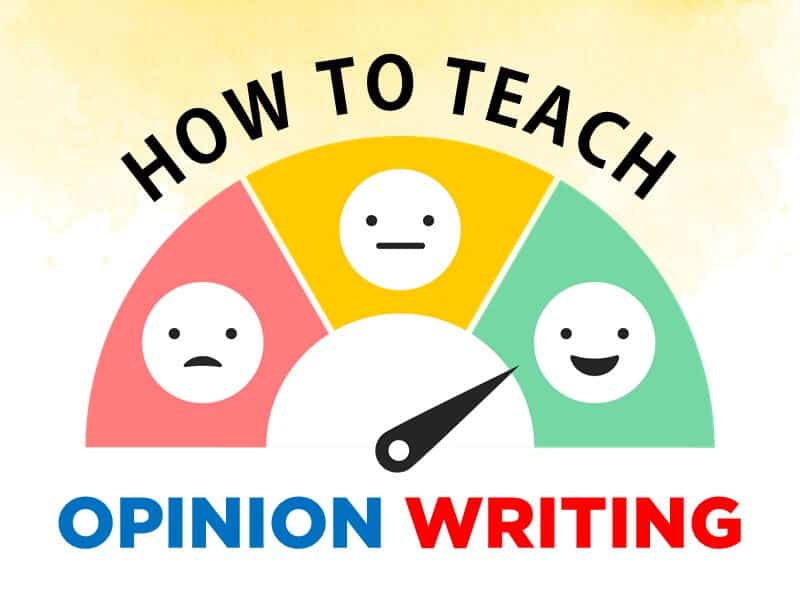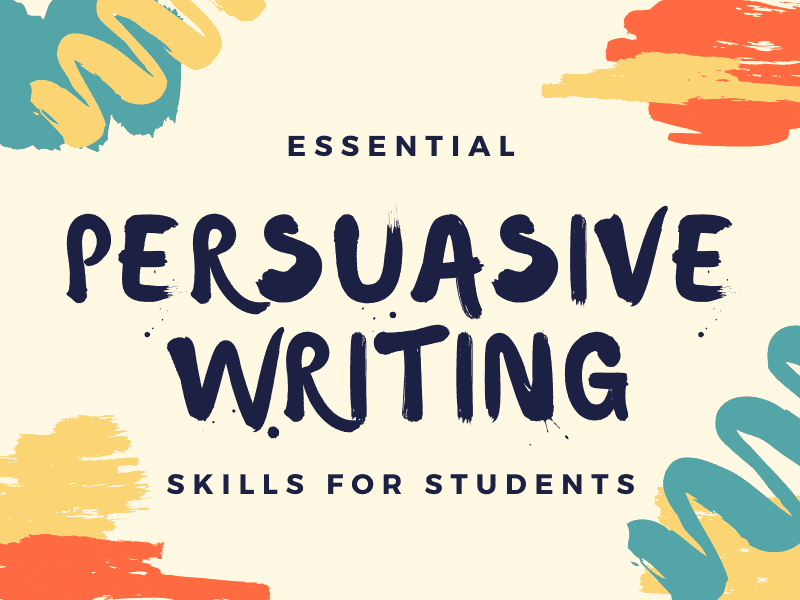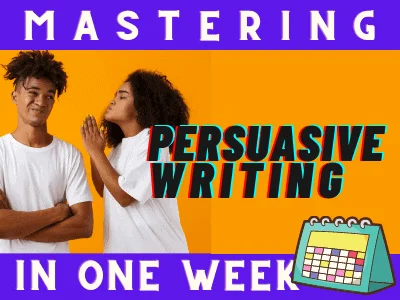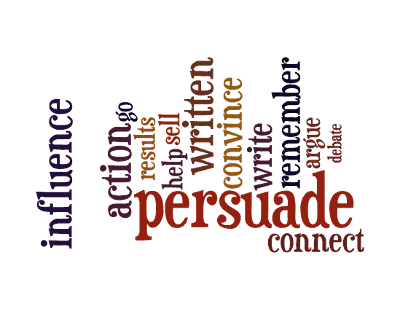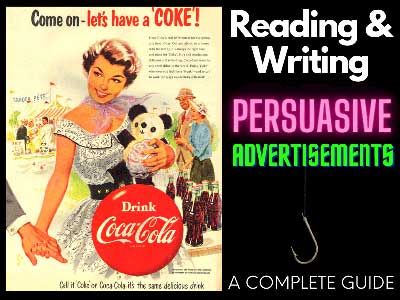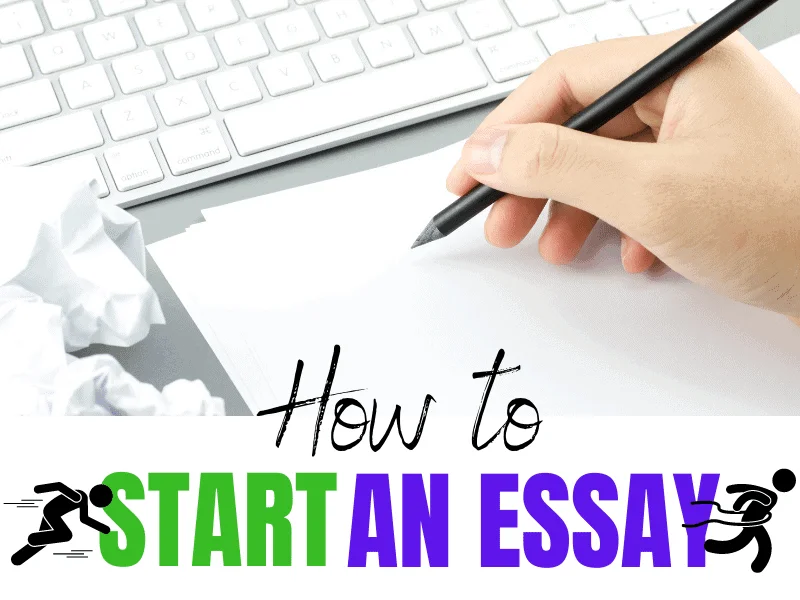WHAT IS A PERSUASIVE ESSAY?

A persuasive text presents a point of view around a topic or theme that is backed by evidence to support it.
The purpose of a persuasive text can be varied. Maybe you intend to influence someone’s opinion on a specific topic, or you might aim to sell a product or service through an advertisement.
The challenge in writing a good persuasive text is to use a mix of emotive language and, in some cases, images that are supported by hard evidence or other people’s opinions.
In a persuasive essay or argument essay, the student strives to convince the reader of the merits of their opinion or stance on a particular issue. The student must utilise several persuasive techniques to form a coherent and logical argument to convince the reader of a point of view or to take a specific action.
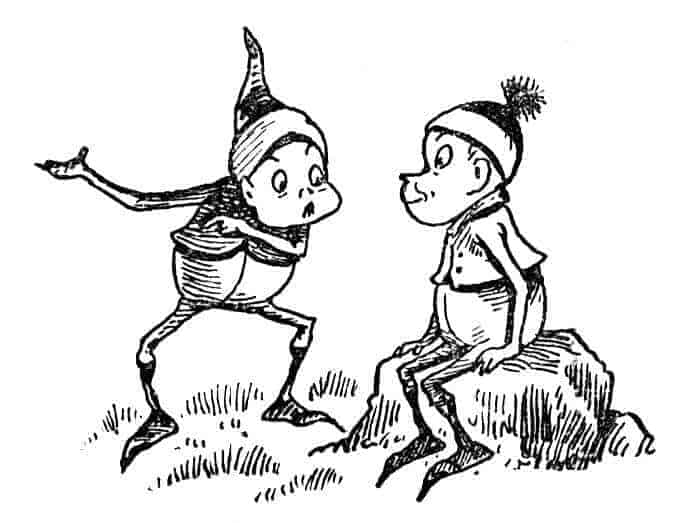
PERSUADING PEOPLE REQUIRES A CONSISTENT APPROACH…
Persuasive texts are simple in structure. You must clearly state your opinion around a specific topic and then repeatedly reinforce your opinions with external facts or evidence. A robust concluding summary should leave little doubt in the reader’s mind. ( Please view our planning tool below for a detailed explanation. )
TYPES OF PERSUASIVE TEXT
We cover the broad topic of writing a general persuasive essay in this guide, there are several sub-genres of persuasive texts students will encounter as they progress through school. We have complete guides on these text types, so be sure to click the links and read these in detail if required.
- Argumentative Essays – These are your structured “Dogs are better pets than Cats” opinion-type essays where your role is to upsell the positive elements of your opinions to your audience whilst also highlighting the negative aspects of any opposing views using a range of persuasive language and techniques.
- Advertising – Uses persuasive techniques to sell a good or service to potential customers with a call to action.
- Debating Speeches – A debate is a structured discussion between two teams on a specific topic that a moderator judges and scores. Your role is to state your case, sell your opinions to the audience, and counteract your opposition’s opinions.
- Opinion Articles, Newspaper Editorials. – Editorials often use more subtle persuasive techniques that blur the lines of factual news reporting and opinions that tell a story with bias. Sometimes they may even have a call to action at the end.
- Reviews – Reviews exist to inform others about almost any service or product, such as a film, restaurant, or product. Depending on your experiences, you may have firm opinions or not even care that much about recommending it to others. Either way, you will employ various persuasive techniques to communicate your recommendations to your audience.
- Please note a DISCUSSION essay is not a traditional persuasive text, as even though you are comparing and contrasting elements, the role of the author is to present an unbiased account of both sides so that the reader can make a decision that works best for them. Discussions are often confused as a form of persuasive writing.
A COMPLETE TEACHING UNIT ON PERSUASIVE WRITING SKILLS
Teach your students to produce writing that PERSUADES and INFLUENCES thinking with this HUGE writing guide bundle covering: ⭐ Persuasive Texts / Essays ⭐ Expository Essays⭐ Argumentative Essays⭐ Discussions.
A complete 140 PAGE unit of work on persuasive texts for teachers and students. No preparation is required.
THE STRUCTURE OF A PERSUASIVE ESSAY
1. Introduction
In the introduction, the student will naturally introduce the topic. Controversial issues make for great topics in this writing genre. It’s a cliche in polite society to discourage discussions involving politics, sex, or religion because they can often be very divisive. While these subjects may not be the best topics of conversation for the dinner table at Thanksgiving, they can be perfect when deciding on a topic for persuasive writing. Obviously, the student’s age and abilities should be considered, as well as cultural taboos, when selecting a topic for the essay. But the point holds, the more controversial, the better.
Let’s take a look at some of the critical elements of the introduction when writing a persuasive essay:
Title: Tell your audience what they are reading.
This will often be posed as a question; for example, if the essay is on the merits of a vegetarian lifestyle, it may be called something like: To Eat Meat or Not?
Hook: Provide your audience with a reason to continue reading.
As with any genre of writing, capturing the reader’s interest from the outset is crucial. There are several methods of doing this, known as hooks. Students may open their essays with anecdotes, jokes, quotations, or relevant statistics related to the topic under discussion.
Background: Provide some context to your audience.
In this introductory section, students will provide the reader with some background on the topic. This will place the issue in context and briefly weigh some opinions on the subject.
Thesis statement: Let the audience know your stance.
After surveying the topic in the first part of the introduction, it is now time for the student writer to express their opinion and briefly preview the points they will make later in the essay.
2. Body Paragraphs
The number of paragraphs forming this essay section will depend on the number of points the writer chooses to make to support their opinion. Usually three main points will be sufficient for beginning writers to coordinate. More advanced students can increase the number of paragraphs based on the complexity of their arguments, but the overall structure will largely remain intact.
Be sure to check out our complete guide to writing perfect paragraphs here.
The TEEL acronym is valuable for students to remember how to structure their paragraphs. Read below for a deeper understanding.
Topic Sentence:
The topic sentence states the central point of the paragraph. This will be one of the reasons supporting the thesis statement made in the introduction.
Explain:
These sentences will build on the topic sentence by illustrating the point further, often by making it more specific.
Evidence:
These sentences’ purpose is to support the paragraph’s central point by providing supporting evidence and examples. This evidence may be statistics, quotations, or anecdotal evidence.
Link:
The final part of the paragraph links back to the initial statement of the topic sentence while also forming a bridge to the next point to be made. This part of the paragraph provides some personal analysis and interpretation of how the student arrived at their conclusions and connects the essay as a cohesive whole.
3. Conclusion
The conclusion weaves together the main points of the persuasive essay. It does not usually introduce new arguments or evidence but instead reviews the arguments made already and restates them by summing them up uniquely. It is important at this stage to tie everything back to the initial thesis statement. This is the writer’s last opportunity to drive home their point, to achieve the essay’s goal, to begin with – persuade the reader of their point of view.

Ending an essay well can be challenging, but it is essential to end strongly, especially for persuasive essays. As with the hooks of the essay’s opening, there are many tried and tested methods of leaving the reader with a strong impression. Encourage students to experiment with different endings, for example, concluding the essay with a quotation that amplifies the thesis statement.
Another method is to have the student rework their ending in simple monosyllabic words, as simple language often has the effect of being more decisive in impact. The effect they are striving for in the final sentence is the closing of the circle.
Several persuasive writing techniques can be used in the conclusion and throughout the essay to amp up the persuasive power of the writing. Let’s take a look at a few.
ETHOS, PATHOS & LOGOS TUTORIAL VIDEO (2:20)
TIPS FOR WRITING A GREAT PERSUASIVE ESSAY

PERSUASIVE TECHNIQUES
In this article, we have outlined a basic structure that will be helpful to students in approaching the organization of their persuasive writing. It will also be helpful for the students to be introduced to a few literary techniques that will help your students to present their ideas convincingly. Here are a few of the more common ones:
Repetition: There is a reason why advertisements and commercials are so repetitive – repetition works! Students can use this knowledge to their advantage in their persuasive writing. It is challenging to get the reader to fully agree with the writer’s opinion if they don’t fully understand it. Saying the same thing in various ways ensures the reader gets many bites at the ‘understanding’ cherry.
Repetition Example: “The use of plastic bags is not only bad for the environment, but it is also bad for our economy. Plastic bags are not biodegradable, meaning they will not decompose and will continue to take up space in landfills. Plastic bags are also not recyclable, meaning they will not be reused and will instead end up in landfills. Plastic bags are not only bad for the environment, but they are also bad for our economy as they are costly to dispose of and take up valuable space in landfills.”
In this example, the phrase “not only bad for the environment but also bad for our economy” is repeated multiple times to reinforce the idea that plastic bags are not just a problem for the environment but also the economy. The repetition of the phrase emphasizes the point and makes it more persuasive.
It is also important to note that repetition could be used differently, such as repeating a word or phrase to create rhythm or emphasis.
Storytelling: Humans tend to understand things better through stories. Think of how we teach kids important values through time-tested fables like Peter and the Wolf. Whether through personal anecdotes or references to third-person experiences, stories help climb down the ladder of abstraction and reach the reader on a human level.
Storytelling Example: “Imagine you are walking down the street, and you come across a stray dog clearly in need of food and water. The dog looks up at you with big, sad eyes, and you cannot help but feel a twinge of compassion. Now, imagine that same scenario, but instead of a stray dog, it’s a homeless person sitting on the sidewalk. The person is clearly in need of food and shelter, and their eyes also look up at her with a sense of hopelessness.
The point of this story is to show that just as we feel compelled to help a stray animal in need, we should also feel compelled to help a homeless person. We should not turn a blind eye to the suffering of our fellow human beings, and we should take action to address homelessness in our community. It is important to remember that everyone deserves a roof over their head and a warm meal to eat. The story is designed to elicit an emotional response in the reader and make the argument more relatable and impactful.
By using storytelling, this passage creates an image in the reader’s mind and creates an emotional connection that can be more persuasive than just stating facts and figures.
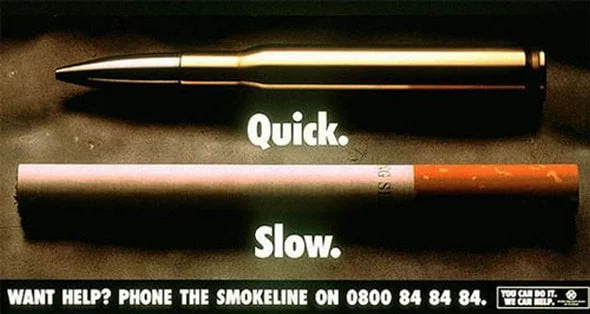
Dissent: We live in a cynical age, so leaving out the opposing opinion will smack of avoidance to the reader. Encourage your students to turn to that opposing viewpoint and deal with those arguments in their essays.
Dissent Example: “Many people argue that students should not have to wear uniforms in school. They argue that uniforms stifle creativity and individuality and that students should be able to express themselves through their clothing choices. While these are valid concerns, I strongly disagree.
In fact, uniforms can actually promote individuality by levelling the playing field and removing the pressure to dress in a certain way. Furthermore, uniforms can promote a sense of community and belonging within a school. They can also provide a sense of discipline and structure, which can help to create a more focused and productive learning environment. Additionally, uniforms can save families money and eliminate the stress of deciding what to wear daily.
While some may argue that uniforms stifle creativity and individuality, the benefits of uniforms far outweigh the potential drawbacks. It is important to consider the impact of uniforms on the school as a whole, rather than focusing solely on individual expression.”
In this example, the writer presents the opposing viewpoint (uniforms stifle creativity and individuality) and then provides counterarguments to refute it. By doing so, the writer can strengthen their own argument and present a more convincing case for why uniforms should be worn in school.
A Call to Action: A staple of advertising, a call to action can also be used in persuasive writing. When employed, it usually forms part of the conclusion section of the essay and asks the reader to do something, such as recycle, donate to charity, sign a petition etc.
A quick look around reveals to us the power of persuasion, whether in product advertisements, newspaper editorials, or political electioneering; persuasion is an ever-present element in our daily lives. Logic and reason are essential in persuasion, but they are not the only techniques. The dark arts of persuasion can prey on emotion, greed, and bias. Learning to write persuasively can help our students recognize well-made arguments and help to inoculate them against the more sinister manifestations of persuasion.
Call to Action Example: “Climate change is a pressing issue that affects us all, and it’s important that we take action now to reduce our carbon footprint and protect the planet for future generations. As a society, we have the power to make a difference and it starts with small changes that we can make in our own lives.
I urge you to take the following steps to reduce your carbon footprint:
- Reduce your use of single-use plastics
- Use public transportation, carpool, bike or walk instead of driving alone.
- Support clean energy sources such as solar and wind power
- Plant trees and support conservation efforts
It’s easy to feel like one person can’t make a difference, but the truth is that every little bit helps. Together, we can create a more sustainable future for ourselves and for the planet.
So, let’s take action today and make a difference for a better future, it starts with minor changes, but it all adds up and can make a significant impact. We need to take responsibility for our actions and do our part to protect the planet.”
In this example, the writer gives a clear and specific call to action and encourages the reader to take action to reduce their carbon footprint and protect the planet. By doing this, the writer empowers the reader to take action and enables them to change.
Now, go persuade your students of the importance of perfecting the art of persuasive writing!
20 POPULAR PERSUASIVE ESSAY TOPICS FOR STUDENTS
Writing an effective persuasive essay demonstrates a range of skills that will be of great use in nearly all aspects of life after school.

In essence, if you can influence a person to change their ideas or thoughts on a given topic through how you structure your words and thoughts, you possess a very powerful skill.
Be careful not to rant wildly. Use facts and other people’s ideas who think similarly to you in your essay to strengthen your concepts.
Your biggest challenge in getting started may be choosing a suitable persuasive essay topic. These 20 topics for a persuasive essay should make this process a little easier.
- WHY ARE WE FASCINATED WITH CELEBRITIES AND WEALTHY PEOPLE ON TELEVISION AND SOCIAL MEDIA?
- IS IT RIGHT FOR SCHOOLS TO RAISE MONEY BY SELLING CANDY AND UNHEALTHY FOODS TO STUDENTS?
- SHOULD GIRLS BE ALLOWED TO PLAY ON BOYS SPORTING TEAMS?
- IS TEACHING HANDWRITING A WASTE OF TIME IN THIS DAY AND AGE?
- SHOULD THERE BE FAR GREATER RESTRICTIONS AROUND WHAT CAN BE POSTED ON THE INTERNET?
- SHOULD PROFESSIONAL ATHLETES HAVE TO TAKE DRUG TESTS?
- ARE TEENAGE PREGNANCY SHOWS A NEGATIVE OR POSITIVE INFLUENCE ON VIEWERS?
- SHOULD GAMBLING BE PROMOTED IN ANY WAY IN SPORTS EVEN THOUGH IT BRINGS IN LARGE AMOUNTS OF REVENUE?
- SHOULD SPORTING TEAMS THAT LOSE BE REWARDED BY RECEIVING INCENTIVES SUCH AS HIGH DRAFT PICKS AND / OR FINANCIAL BENEFITS?
- SHOULD SHARKS THAT ATTACK PEOPLE BE DESTROYED? SHOULD WE GET INVOLVED IN FOREIGN CONFLICTS AND ISSUES THAT DON’T DIRECTLY AFFECT OUR COUNTRY?
- SHOULD WE GET INVOLVED IN FOREIGN CONFLICTS AND ISSUES THAT DON’T DIRECTLY AFFECT OUR COUNTRY?
- COULD VIDEO GAMES BE CONSIDERED AS A PROFESSIONAL SPORT?
- IF YOU WERE THE LEADER OF YOUR COUNTRY AND HAD A LARGE SURPLUS TO SPEND, WHAT WOULD YOU DO WITH IT?
- WHEN SHOULD A PERSON BE CONSIDERED AND TREATED AS AN ADULT?
- SHOULD SMOKING BECOME AN ILLEGAL ACTIVITY?
- SHOULD THE VOTING AGE BE LOWERED?
- DOES PROTECTIVE PADDING IN SPORTS MAKE IT MORE DANGEROUS?
- SHOULD CELL PHONES BE ALLOWED IN THE CLASSROOM?
- IS TEACHING A FOREIGN LANGUAGE A WASTE OF TIME?
- SHOULD WE TEACH ETIQUETTE IN SCHOOLS?
PERSUASIVE PROMPTS FOR RELUCTANT WRITERS
If your students need a little more direction and guidance, here are some journal prompts that include aspects to consider.
- Convince us that students would be better off having a three-day weekend. There are many angles you could take with this, such as letting children maximize their childhood or trying to convince your audience that a four-day school week might actually be more productive.
- Which is the best season? And why? You will really need to draw on the benefits of your preferred season and sell them to your audience. Where possible, highlight the negatives of the competing seasons. Use lots of figurative language and sensory and emotional connections for this topic.
- Aliens do / or don’t exist? We can see millions of stars surrounding us just by gazing into the night sky, suggesting alien life should exist, right? Many would argue that if there were aliens we would have seen tangible evidence of them by now. The only fact is that we just don’t know the answer to this question. It is your task to try and convince your audience through some research and logic what your point of view is and why.
- Should school uniforms be mandatory? Do your research on this popular and divisive topic and make your position clear on where you stand and why. Use plenty of real-world examples to support your thoughts and points of view.
- Should Smartphones be banned in schools? Whilst this would be a complete nightmare for most students’ social lives, maybe it might make schools more productive places for students to focus and learn. Pick a position, have at least three solid arguments to support your point of view, and sell them to your audience.
VISUAL JOURNAL PROMPTS FOR PERSUASIVE WRITING
Try these engaging, persuasive prompts with your students to ignite the writing process. Scroll through them.
Persuasive Essay Examples (Student Writing Samples)
Below are a collection of persuasive essay samples. Click on the image to enlarge and explore them in greater detail. Please take a moment to read the persuasive texts in detail and the teacher and student guides highlight some of the critical elements of writing a persuasion.
Please understand these student writing samples are not intended to be perfect examples for each age or grade level but a piece of writing for students and teachers to explore together to critically analyze to improve student writing skills and deepen their understanding of persuasive text writing.
We recommend reading the example either a year above or below, as well as the grade you are currently working with, to gain a broader appreciation of this text type.
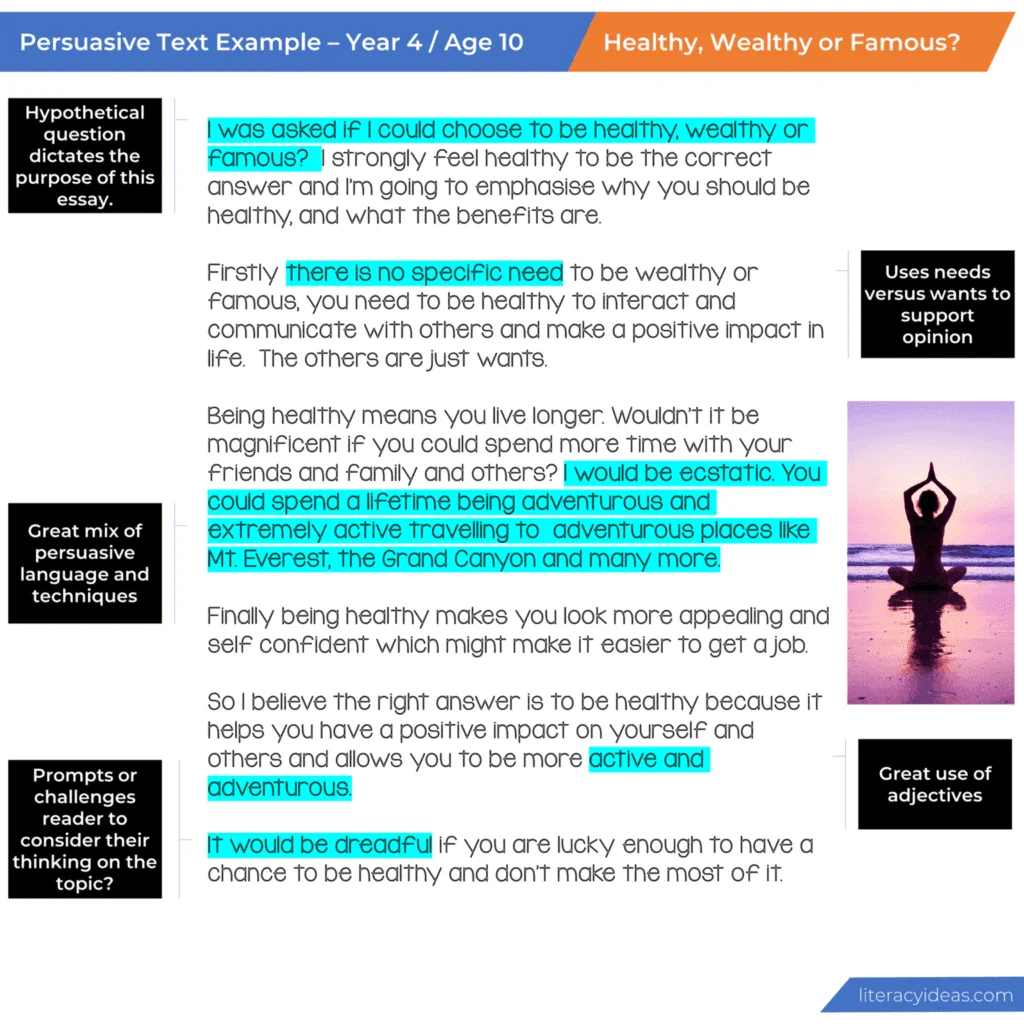

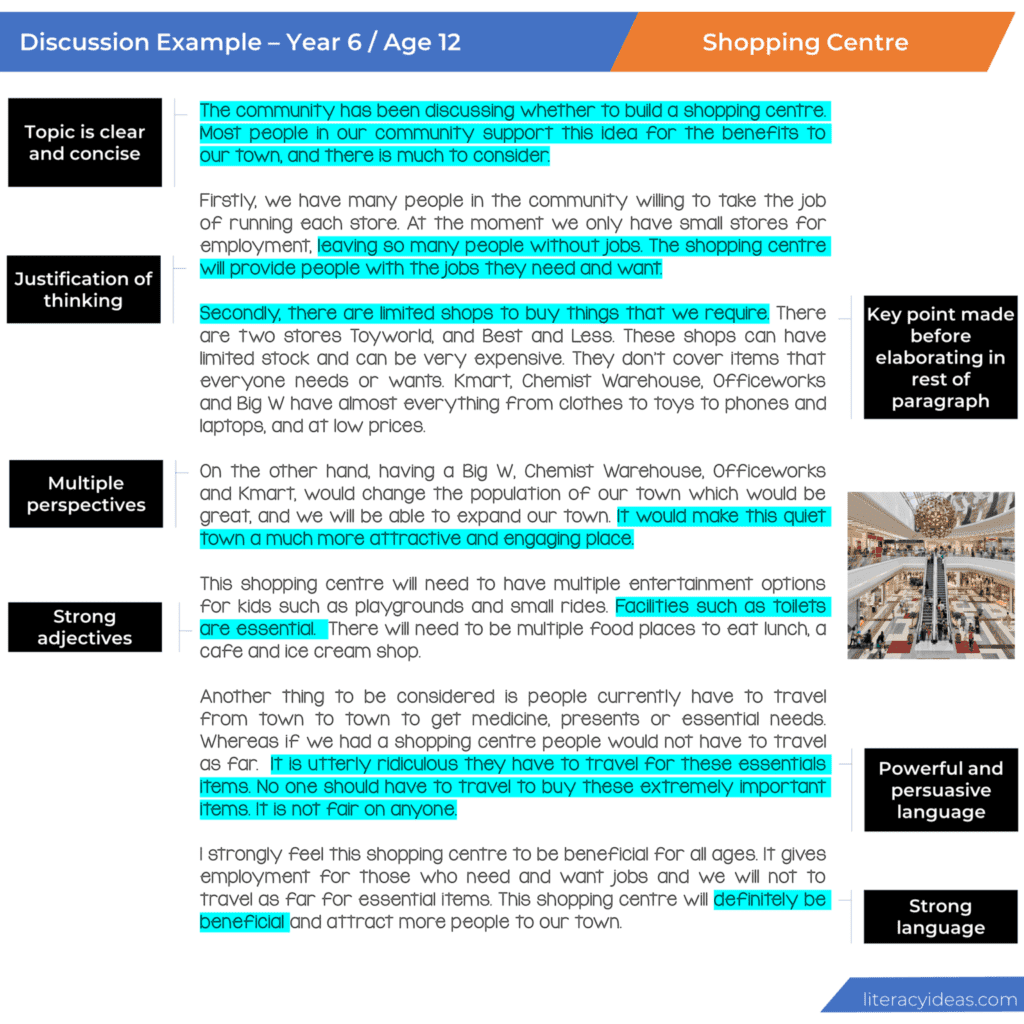
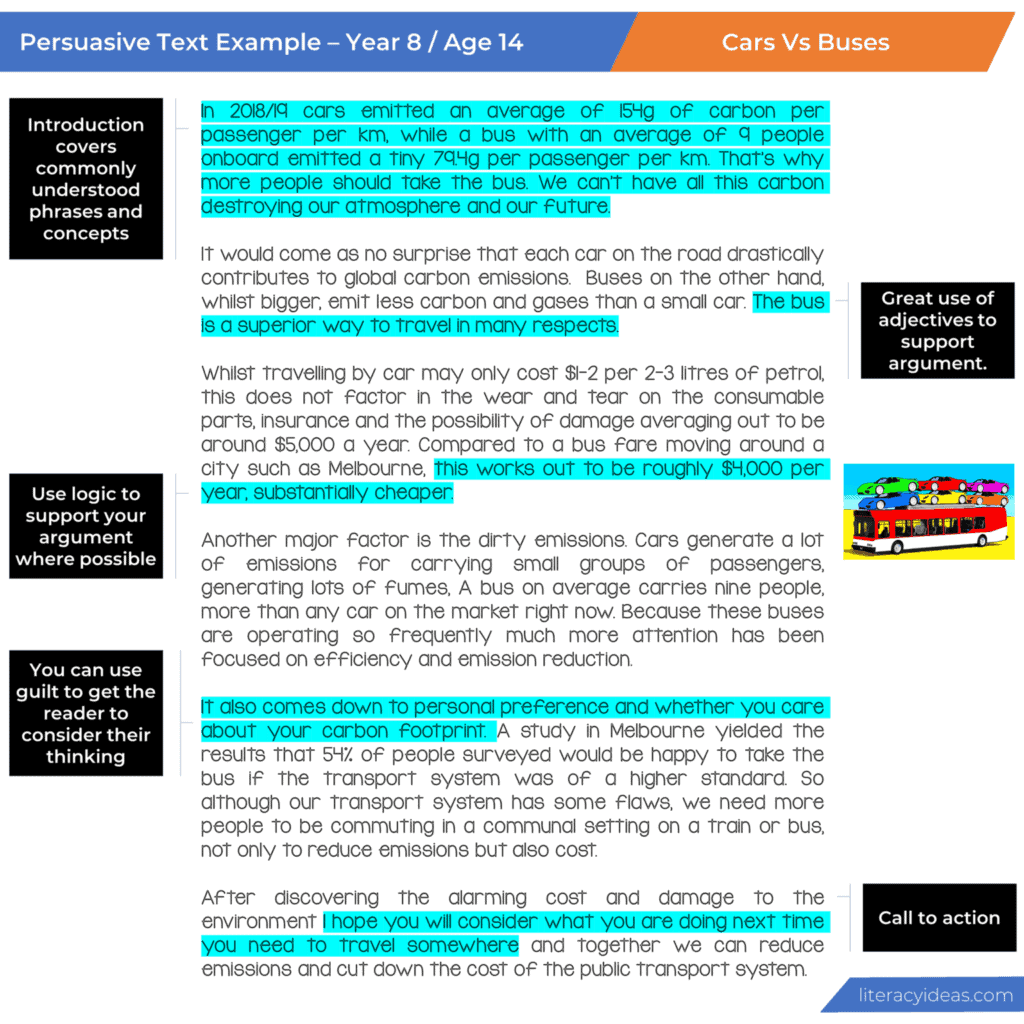
VIDEO TUTORIALS FOR PERSUASIVE WRITING
OTHER GREAT ARTICLES RELATED TO PERSUASIVE ESSAY WRITING
Teaching Resources
Use our resources and tools to improve your student’s writing skills through proven teaching strategies.
WHERE CAN I FIND A COMPLETE UNIT OF WORK ON HOW TO WRITE PERSUASIVE ESSAYS?
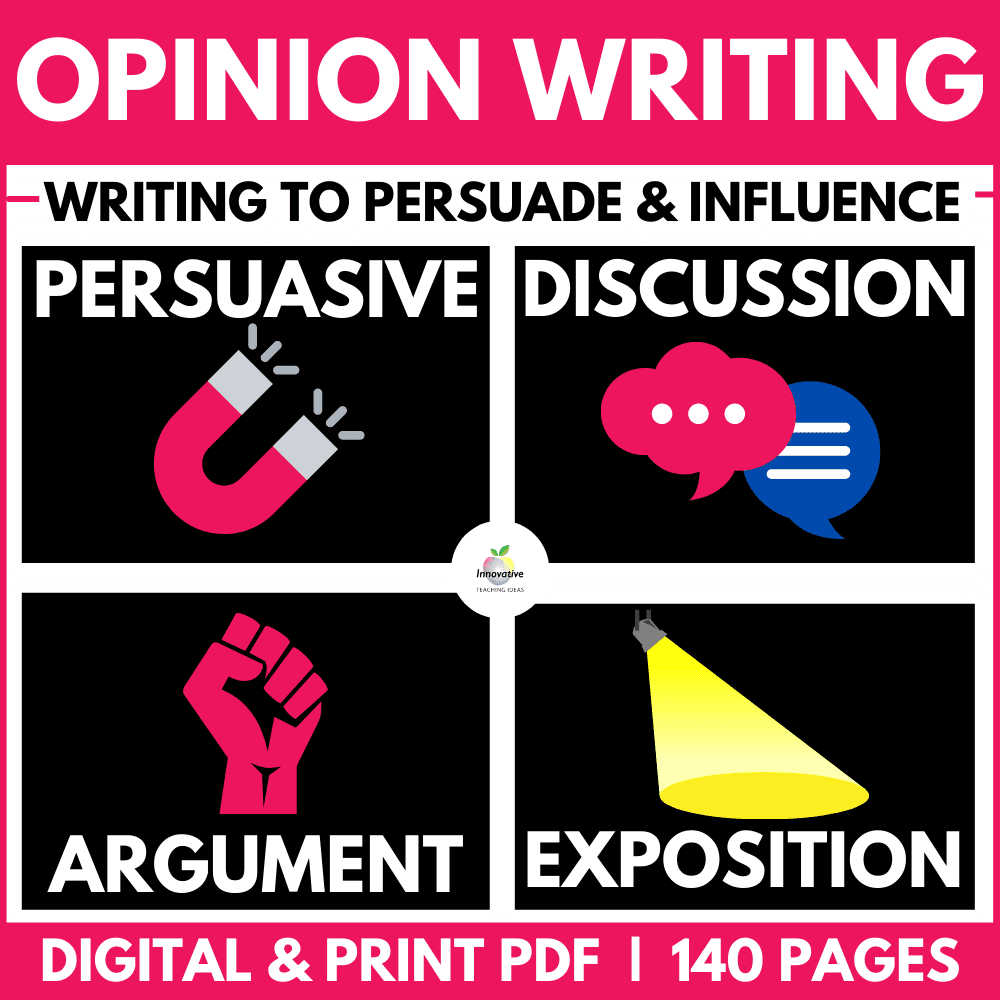
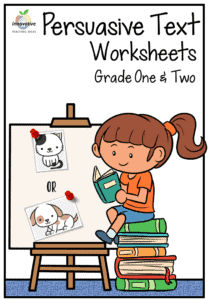
We pride ourselves on being the web’s best resource for teaching students and teachers how to write a persuasive text. We value the fact you have taken the time to read our comprehensive guides to understand the fundamentals of writing skills.
We also understand some of you just don’t have the luxury of time or the resources to create engaging resources exactly when you need them.
If you are time-poor and looking for an in-depth solution that encompasses all of the concepts outlined in this article, I strongly recommend looking at the “Writing to Persuade and Influence Unit.”
Working in partnership with Innovative Teaching Ideas, we confidently recommend this resource as an all-in-one solution to teach how to write persuasively.
This unit will find over 140 pages of engaging and innovative teaching ideas.
PERSUASIVE ESSAY WRITING CHECKLIST AND RUBRIC BUNDLE
⭐⭐⭐⭐⭐ (92 Reviews)


